Netac Z5 USB 3.1 Gen 2 Portable SSD Review
by Ganesh T S on August 9, 2016 8:00 AM ESTDirect-Attached Storage Benchmarks
Netac claims read and write speeds of 747 MBps and 723 MBps respectively, and these are backed up by the ATTO benchmarks provided below. Unfortunately, these access traces are not very common in real-life scenarios.
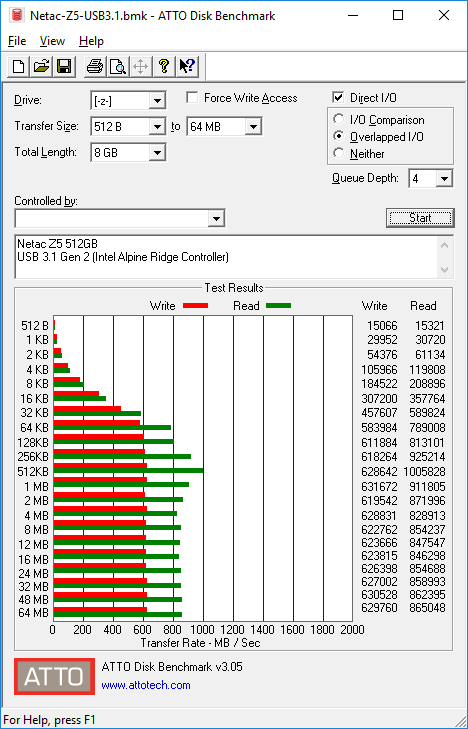
CrystalDiskMark, despite being a canned benchmark, provides a better estimate of the performance range with a selected set of numbers. As evident from the screenshot below, the performance can dip to as low as 19 MBps for random 4K reads.
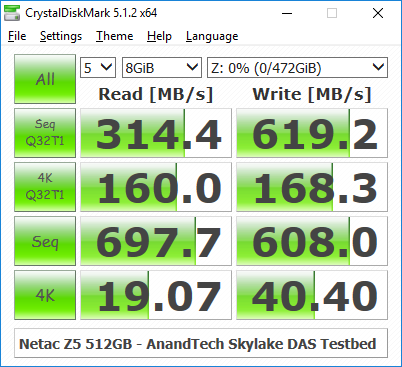
Benchmarks - robocopy and PCMark 8 Storage Bench
Our testing methodology for DAS units also takes into consideration the usual use-case for such devices. The most common usage scenario is transfer of large amounts of photos and videos to and from the unit. The minor usage scenario is importing files directly off the DAS into a multimedia editing program such as Adobe Photoshop.
In order to tackle the first use-case, we created three test folders with the following characteristics:
- Photos: 15.6 GB collection of 4320 photos (RAW as well as JPEGs) in 61 sub-folders
- Videos: 16.1 GB collection of 244 videos (MP4 as well as MOVs) in 6 sub-folders
- BR: 10.7 GB Blu-ray folder structure of the IDT Benchmark Blu-ray (the same that we use in our robocopy tests for NAS systems)






For the second use-case, we take advantage of PC Mark 8's storage bench. The storage workload involves games as well as multimedia editing applications. The command line version allows us to cherry-pick storage traces to run on a target drive. We chose the following traces.
- Adobe Photoshop (Light)
- Adobe Photoshop (Heavy)
- Adobe After Effects
- Adobe Illustrator
Usually, PC Mark 8 reports time to complete the trace, but the detailed log report has the read and write bandwidth figures which we present in our performance graphs. Note that the bandwidth number reported in the results don't involve idle time compression. Results might appear low, but that is part of the workload characteristic. Note that the same testbed is being used for all DAS units. Therefore, comparing the numbers for each trace should be possible across different DAS units.


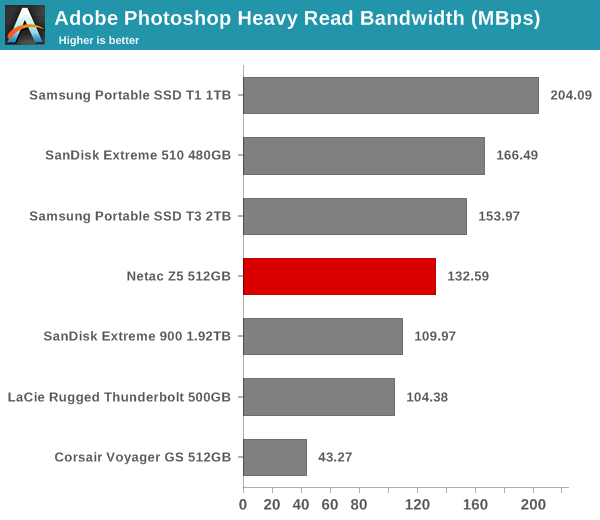

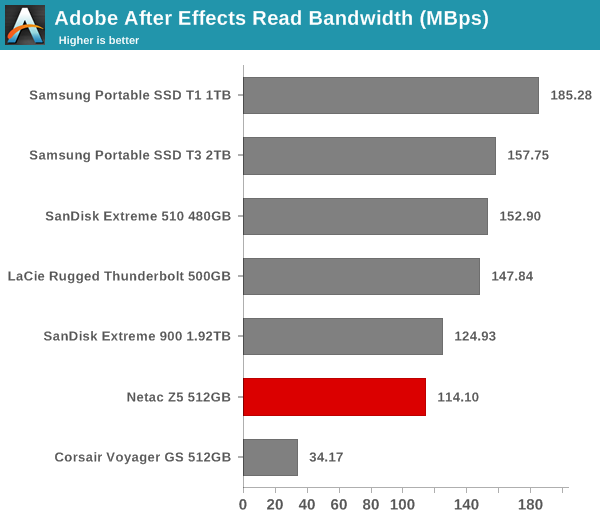
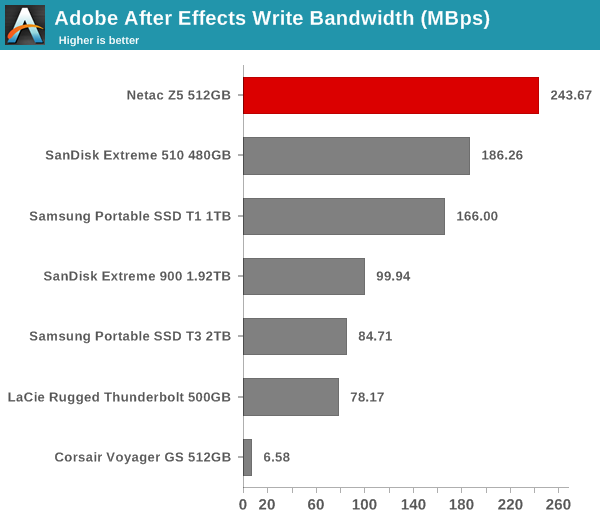
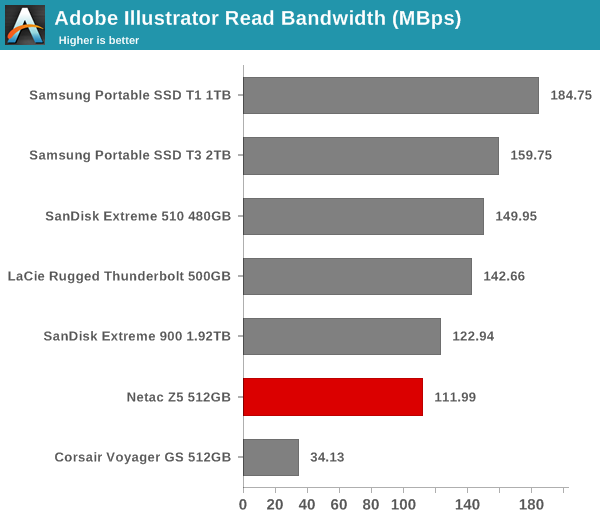

The Netac Z5 512GB unit manages to be in the top two in almost all of the test traces. There are certain workloads that are unable to take advantage of two SSDs in RAID-0, and in those, we can see that the Netac Z5 performs similar to the SanDisk Extreme 900 (which also has a similar RAID-0 configuration). In any case, our direct-attached storage benchmarks show that the Netac Z5 is an excellent performer when it comes to real-world use-cases.










22 Comments
View All Comments
BrokenCrayons - Wednesday, August 10, 2016 - link
The skin temp of the Netac case was 46C. By the time heat reaches the exterior and is measured by an IR camera, it's dispersed from the sources that are creating it. This implies the internal temps experienced by the flash storage inside is higher. The good news is the Netac isn't throttling due to temperature as is made clear by the review. The temps measured were under atypically high demand too so day-to-day file copies wouldn't likely create that situation. However, since Ganesh has pointed out the company is aware of the thermal performance as a shortcoming, I think being dismissive of thermal concerns might be a mistake.Samus - Wednesday, August 10, 2016 - link
It's true using thermal pads to mate the controllers to the chassis will improve thermals, but if the drive isn't throttling, it is within design specifications, which means according to the manufacture reliability wont be sacrificed. So Netac concerning themselves with the thermals is superficial, and anything they do to improve them is a solution looking for a problem.I don't like my gadgets hot anymore than the next guy, but sometimes that's just how they are designed.
LordConrad - Tuesday, August 9, 2016 - link
"ASMedia's custom drivers for ASM1142 are no longer needed, given that Windows 10 bundles a Microsoft USB 3.1 xHCI driver."You should not assume that everyone is using Windows 10.
Samus - Tuesday, August 9, 2016 - link
Why aren't you using Windows 10? It was free for a whole year. Free!KingofL337 - Tuesday, August 9, 2016 - link
Would you really be willing to trust your data to some fly by night company? I can understand it's fast bust still.ganeshts - Tuesday, August 9, 2016 - link
I would hardly call Netac a 'fly by night' company given their background.Btw, if we even have a little bit of inkling / doubt that some vendor is a 'fly by night' operation, we would definitely NOT be reviewing their wares.
KingofL337 - Wednesday, August 10, 2016 - link
Maybe, 'fly by night' if the wrong wording how about 'unproven'.it looks like they took a reference design for the SM2246EN and slapped or will slap a set of the cheapest mSATA drives to the board. They aren't using their flash or Dram. They aren't available in the US except Amazon and they sell mostly cheap USB drives, uSD cards and a few HDDs with almost no reviews. Googling them basically shows their page, Amazon and this review.
These comments sure makes me feel warm inside.
Never been reviewed before or almost anyone else.
Prior to going into the specifics of the Netac Z5, a few words about Netac are in order, as none of their products have been reviewed by us before.
Not their own Flash, Dram or Controller
They use the Silicon Motion SM2246EN controller with Nanya DRAM and Micron NAND flash. Based on the package markings, it appears that the mSATA SSDs are using Micron MLC flash.
No Trim on a SSD, so this things is going to slow to a crawl.
TRIM support is shown in the information view, but, it is not possible to activate it behind the bridge chip.
No attempt at a thermal solution
In terms of actual thermal design, we were quite surprised to find that neither the SSD controllers nor the flash packages had any sort of thermal pad to aid in transferring the generated heat to the metal body.
Also these Chinese companies are adding no R&D effort slapping together or borrowing the design of these drives and marking them down a little and selling them. We put our data on them and they fail and so does all our data. We would never by a spinning disc made by a company like this.
ganeshts - Wednesday, August 10, 2016 - link
Other than Samsung, SanDisk and Micron / Crucial - who makes their own flash, DRAM or controller?So, if a company well-established in the Chinese market wants to get a presence / enter into the US market, does one immediately dismiss them because they haven't been reviewed by anyone in the US / EU press circles?
Btw, many of the flash devices that people buy in the US / EU are just the OEM designs developed by companies like Netac so that 'well-known' companies can just slap their labels on it and distribute with minimal QA work. That is how OEM designing works in the current day.
FWIW, the company is targeting distributors in the US market (not end buyers directly) with the Z5. So, someone who wants to distribute / slap their label on the Z5 can make Netac put in an improved thermal solution and/or improve firmware aspects before placing the bulk order.
name99 - Tuesday, August 9, 2016 - link
8W draw and no power brick? AND A USB-C to A cable. So they EXPECT you to run this on USB3 where the max guaranteed power supply is 4.5W?At the very least AnandTech should have run all tests under that scenario to see what happens. Does the box gratefully degrade, or does it just randomly disconnect when the power draw goes too high?
ganeshts - Tuesday, August 9, 2016 - link
We have been through this discussion on the USB 3.1 Gen 2 SanDisk Extreme 900 review also,At the outset - the usecase for this device is specifically with USB 3.1 Gen 2 ports.
Second, with USB 2.0 or USB 3.0 ports - it works without disconnects but performance is very limited, not crossing 400 MBps even in artificial workloads. I don't have a setup to measure power consumption with non-Type-C / USB 3.0 / USB 2.0 ports. So, I can't provide power numbers for those cases.